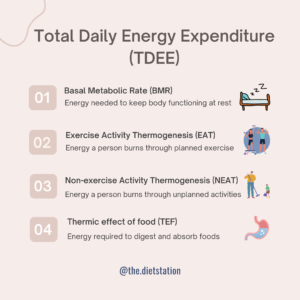By Tina Wong
First, we have to learn about the TDEE equation.
So, what is the TDEE formula? TDEE is total daily energy expenditure which is how much calories you have to consume per day to maintain your weight and metabolism.

To simplify,
- If you consume more than your TDEE, you gain weight
- If you consume the same amount as TDEE, maintain weight
- If you consume less than your TDEE, you lose weight
You can check your TDEE using an online calculator.
TDEE is calculated by adding up 4 numbers, BMR (Basal Metabolic rate), EAT (exercise activity thermogenesis), NEAT (non-exercise activity thermogenesis) and TEF (Thermic effect of food).
TDEE = BMR + EAT + NEAT + TEF
What is BMR?
BMR (basal metabolic rate) is the most important part consisting of 60-70% of TDEE. This is the minimum amount of calories your body needs to maintain functions even if you are at rest. There are a few factors affecting BMR which are gender, body size, age, muscle mass, nutrition deficiencies etc. It is therefore important that you eat enough to reach your BMR, regardless of your goal to gain weight or lose weight. If you restrict your diet below the BMR over a prolonged period, your metabolism will begin to slow down due to muscle loss.
What you need to know about EAT vs NEAT
EAT refers to energy burned through planned exercise. Although it takes up to only 5% of the TDEE, regular exercise is still recommended to maintain muscle mass. EAT would however be higher than 5% for athletes. Nonetheless, many individuals overestimate the effect of exercises on weight loss. Based on Harvard Health Publishing, a 70kg person can burn up to 108 calories by only doing half hour weightlifting. It is also recommended that adults have 2.5 to 5 hours of moderate physical activities per week, according to the AGDH guidelines. Physical activities are very important during weight loss process, however, if you consume more energy than you burned, you will still gain weight!
NEAT refers to energy burned through unplanned/ daily activities such as walking, doing housework and cooking. NEA consists of 10-15% of TDEE. This includes walking, doing housework and cooking. An accumulation of several small tasks can give you a significant energy burn.
*An athlete’s EAT and NEAT can go up to 30% of TDEE compared to a sedentary individual with 15% only.
What is TEF?
TEF, Thermic effect of food, takes up to about 10% of TDEE. TEF is the energy required for digestion, processing, and absorption of foods (macronutrients). Among three macronutrients, protein causes highest TEF ~20-30% of energy content of ingested protein, followed by carbohydrates (5-10%) and fats (0-3%) [1].
The reason why our TDEE increases when we eat is because we need energy to eat, digest, absorb and process. The energy required depends on the portion size and types of foods you eat. Different macronutrients raise your metabolism in different ways. For example,
-
protein increase BMR about 20-30%
-
carbohydrates increase BMR about 5-10%
- fat increase BMR about 0-3%
To summarise, consuming protein has higher TEF than carbohydrate and fat. We therefore recommend increasing protein intake if you’re planning to lose weight!
It is important to know about your daily energy requirement and to achieve a successful weight loss, you will need to:
- Calculate your TDEE
- To lose weight, consume calories less than TDEE but not less than BMR
- Ideal intake would be “BMR< YOUR DAILY INTAKE< TDEE”
- Although NEAT provides more energy burn, it is not recommended to replace planned exercise.
- Increasing protein intake can increase metabolism and maintain muscle mass during weight loss process
About Tina Wong

Tina is an accredited practising Dietitian at CHMC The Mall and a member of Dietitians Australia. She completed her Master of Nutrition and Dietetics from the University of Sydney and attained a Bachelor of Nutrition Science from the University of Wollongong.
Tina has extensive experience working with clients with chronic diseases such as diabetes, obesity, high cholesterol, fatty liver etc. She does not believe in a ‘one-size-fits-all’ approach and understands the importance of a personalised nutrition plan as each person is unique. To learn more about Tina and/or to book an appointment, click here.






